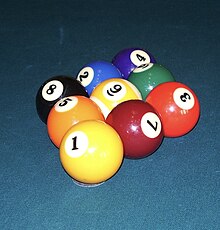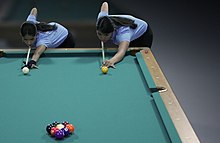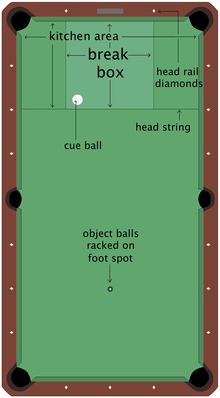Nine-ball
 | |
| Highestgoverning body | World Pool-Billiard Association |
|---|---|
| First played | 1920s |
| Characteristics | |
| Contact | No |
| Team members | single competitors or doubles |
| Mixed-sex | Yes |
| Equipment | Cue sports equipment |
| Glossary | glossary of cue sports terms |
| Presence | |
| Country or region | Worldwide |
| World Games | 2001 |
Nine-ball(sometimes written9-ball) is a discipline of thecue sportpool.The game's origins are traceable to the 1920s in the United States. It is played on a rectangularbilliard tablewithpocketsat each of the four corners and in the middle of each long side. Using acue stick,players must strike the whitecue balltopocketnine coloredbilliard balls,hitting them in ascending numerical order. An individual game (orrack) is won by the player pocketing the9 ball.Matches are usually played as araceto a set number of racks, with the player who reaches the set number winning the match.
The game is currently governed by theWorld Pool-Billiard Association(WPA), with multiple regional tours. The most prestigious nine-ball tournaments are theWPA World Nine-ball Championshipand theU.S. Open Nine-ball Championships.Notable 9-Ball players in the game includeLuther Lassiter,Buddy Hall,Efren Reyes,Earl StricklandandShane Van Boening.The game is often associated withhustlingandgambling,with tournaments often having a "buy-in" amount to become a participant. The sport has featured in popular culture, notably in the 1961 filmThe Hustlerand its 1986 sequelThe Color of Money.
Nine-ball has been played with varied rules, with games such asten-ball,seven-ballandthree-ballbeing derived from the game. While usually a singles sport, the game can be played in doubles, with players completing alternate shots. Examples of tournaments featuring doubles include theWorld Cup of Pool,World Team Championshipand theMosconi Cup.
History
[edit]The game was established in America by 1920,[1][2]although its exact origins are unknown.[3][4]Nine-ball is played with the same equipment aseight-balland other pool games.
Rules
[edit]The game of nine-ball is played on abilliard tablewith sixpockets.Thecue ball,which is usually a solid shade of white (but may be spotted in some tournaments), is struck to hit the nineobject balls,which are numbered 1 through 9, each a distinct color, with the 9 ball typically having a yellow stripe on a white base. The aim of the game is to hit the lowest numbered ball on the table (often referred to as theball on) andpocketballs in succession to eventually pocket the nine-ball.[5]As long as the lowest numbered ball on the table is contacted first by the cueball, and any one or more of the object balls are pocketed in any of the pockets with nofoulbeing committed, a player'sinningcontinues. When the table passes to another player, they must play from where the balls were last positioned, except if the prior inning ended in a foul. In that case, the incoming player takesball in hand,anywhere on the table. The winner is the player who legally pockets the nine-ball, the game'smoney ball,regardless of how many balls have been pocketed beforehand. This can happen earlier than the nine-ball being the sole remaining object ball on the table if it is pocketed via acombinationor other indirect method.[5]
Breaking
[edit]
Each rack begins with the object balls placed in arackand one player playing abreak.[6]The object balls are placed in a diamond-shaped configuration, with the 1-ball positioned at the front on thefoot spot,and the 9-ball placed in the center. The rack used to position the balls may be either triangle-shaped, as is used for eight-ball and other pool games, or a specific diamond-shaped rack that holds only nine balls may be used. Racks are usually made of wood or plastic.[7]A template that lies on the table during the break has also come into use.[7]
The break consists of hitting the 1 ball, with the attempt to pocket any ball. If the 9 ball is successfully potted, the player automatically wins the rack. This is sometimes known as agolden break.[8]Additional rules in some tournaments exist, such as a number of balls having to reach thehead string,and players can be chosen to break alternately or whoever won the preceding rack. The break is often the most crucial shot in nine-ball, as it is possible to win a rack without the opponent having taken a single shot. This is often called abreak and run,or running the rack.[9]Earl Stricklandholds the record for break and runs, after he successfully ran 11 consecutive racks in a tournament in 1996.[10]The first break of a match is sometimes decided by a flip of a coin, but often by playing alag,with both players playing a cue ball down the table, the closest to the top rail winning the initial break.[5][11]
Push out and fouls
[edit]After the break, if no fouls were committed, the shooter has the option to continue the rack as usual, or to play apush out.The rules on a push out are different to those of a regular shot, as the shot does not need to hit a rail or ball.[12]After the push out, the opposing player has the option to play the shot that has been left, or to force their opponent to play on from that location. In early versions of nine-ball the push out could be called at any time during the game, but is now only for the shot after the break.[12][5][13]
If a player misses potting a ball on a shot, or commits a foul shot, then their opponent plays the next shot.[5]A foul shot can involve not making first contact with the lowest numbered ball, pocketing the cue ball, or not making contact with arailwith the object ball.[6]A foul shot for any reason offers the opponentball in hand,which means they can place the cue ball at any location on the table. A player making three successive fouls (for any reason) awards that rack to the opponent.[6]Unlike some other cue sports, such assnooker,players are allowed to jump the cue ball over other balls. However, if any ball leaves the cloth at the end of a shot, it is counted as a foul. Jumping is common in nine-ball, and players often have a dedicated jump cue.[14]
European alterations
[edit]
As of the 2000s, the rules have been somewhat in flux in certain contexts, especially in Europe. TheEuropean Pocket Billiard Federation(EPBF), the WPA-affiliate in Europe, has instituted a requirement on the Euro Tour is that the break shot be taken from a "break box"a rectangular box smaller than the regular nine-ball breaking area.[13][15]While making the money ball on breaks are still possible, they are much more difficult with the break box.[13]This was later used on the annual internationalMosconi Cuptournaments.[16]Another Mosconi Cup rule change in 2007 called for racking such that the 9 ball rather than the 1 ball is on thefoot spot,which further stops overpowered break-off shots.[13]
Governance
[edit]The general rules of the game are fairly consistent and usually do not stray too far from the earliest format set by theBilliard Congress of America(BCA).[17]These later formed the basis of the standardized WPA rules, which the BCA follows as a member, although amateur league play may be governed by similar but slightly different rules promulgated by theAmerican Poolplayers Association(APA) and other organizations.[5]
Tournaments
[edit]Nine-ball events worldwide are run at the highest level by the WPA. TheWPA World Nine-ball Championshiphas events for men, women and junior players. Events are generally open to any player who can pay the entry fee, however, some events are based on qualification. The WPA hosts a world ranking schedule based on WPA events, with other ranking systems also operated by the APA and the EPBF.[18][19]Other major events held by the WPA include theU.S. Open 9-Ball Championship,China Open 9-Ball Championshipand theInternational 9-Ball Open.[20]
In addition,Matchroom Sportruns major international competitions including theMosconi Cup,World Cup of PoolandWorld Pool Masters.[21]
Outside those events held on an worldwide basis, nine-ball is played in continental tour series. Events are held on series such as theDiamond Pool Tour,[22]Asian TourandEuro Tour.[23][24]
Derived games
[edit]
Several games have been derived from nine-ball. Six-ball is essentially identical to nine-ball but with three fewer balls, which are racked in a three-row triangle, with the money ball placed in the center of the back row.[25]According toRudolf Wanderone,the game arose in early 20th century billiard halls; halls charged for matches by the 15 ball rack rather than by table, so players of nine-ball had six balls left over.[25]For this reason, the game is often played with the balls numbered between 10 and 15, with the 15 ball as the money ball.[25]

Seven-ballis also similar to nine-ball, though it differs in two key ways: the game uses only seven object balls, which are racked in a hexagon, and players are restricted to pocketing the money ball on their designated side of the table. William D. Clayton is credited with the game's invention in the early 1980s.[26]While not a common game, it was featured on television broadcasterESPN'sSudden Death Seven-ballwhich aired in the early 2000s.[25]

The most common derivative game is the game often-ball.The game is a more stringent variant, using ten balls in which all pocketed balls must becalled.Unlike in nine-ball, the money ball cannot be pocketed on the break for an instant win. Due to its more challenging nature, and the fact that there is no publicly known technique for reliably pocketing specific object balls on the break shot, there have been suggestions among the professional circuit that ten-ball should replace nine-ball as the pro game of choice,[13]especially since the rise of the nine-ball soft break, which is still legal in most international and non-European competition.[13]Ten-ball has its own world championship known as theWPA World Ten-ball Championship.[27]
Popular culture
[edit]The sport has featured in popular culture, most notably in the 1959 novelThe Hustlerand its1961 film adaptation,[28][29]and the 1984 sequel novelThe Color of Moneyand subsequentfilm.[30]InEndless Ocean: Blue World,Nineball Island, which serves as the player's home base, is won through a game of nine-ball.
See also
[edit]References
[edit]- ^"The History of Billiards".cuecare.Archivedfrom the original on 9 February 2007.Retrieved10 November2006.
- ^Hikock, Ralph."Sports history – Billiards".hickorysports.Archived fromthe originalon 23 February 2002.
- ^Billiards: The Official Rules and Records Book(50th Anniversary Commemorative ed.).Coralville, IA:Billiard Congress of America (BCA). 1998. p. 26.
- ^Hickok, Ralph (2001)."Sports History: Pocket Billiards".hickorysports.Archived fromthe originalon 5 December 2006.Retrieved13 December2006.
- ^abcdef"Billiard Congress of America".bca-pool.Archived fromthe originalon 23 November 2004.Retrieved6 January2020.
- ^abc"9 – Ball Rules".vnea.Archivedfrom the original on 18 May 2019.Retrieved6 January2020.
- ^ab"Billiards Racks Dimensions & Drawings | Dimensions.Guide".dimensions.guide.Retrieved6 January2020.
- ^"Golden Break".billiardsforum.Archivedfrom the original on 1 March 2019.Retrieved6 January2020.
- ^"Break and Run".billiardsforum.Archivedfrom the original on 2 July 2019.Retrieved6 January2020.
- ^"Billiards Digest – Pool's Top Source for News, Views, Tips & More".billiardsdigest.Archivedfrom the original on 18 January 2017.Retrieved6 January2020.
- ^"Starting Strong: How to Win the Lag | Pool Cues and Billiards Supplies at PoolDawg".pooldawg.Retrieved6 January2020.
- ^ab"Rules of Play".WPA Pool.Retrieved14 May2020.
- ^abcdefJewett, Bob (February 2008). "Killing Me Softly?: The Outbreak of the Soft Break Threatens the Game of 9-ball".Billiards Digest.Vol. 30, no. 3. Chicago: Luby Publishing. pp. 34–35.ISSN0164-761X.
- ^"How To Massé and Jump the Cue Ball | Pool Cues and Billiards Supplies at PoolDawg".pooldawg.Retrieved6 January2020.
- ^Panozzo, Mike (February 2008). "Long Live the Cup!".Billiards Digest.Vol. 30, no. 3. Chicago: Luby Publishing. pp. 34–35.ISSN0164-761X.
- ^"Break rules set to change".kozoom.Retrieved7 January2020.
- ^"BCA World Standardized Rules for Nine Ball".BCA pool.Archived fromthe originalon 23 November 2004.
- ^"European Pool Rankings"(PDF).europeanpocketbilliardfederation.Retrieved6 January2020.
- ^"WPA Ranking".WPA Pool.Archivedfrom the original on 23 September 2012.Retrieved6 January2020.
- ^Behrman, Barry (7 July 2011)."Statement From Barry Behrman and Shannon Berhman Paschall-Exclusive to AZB".AzBilliards.Archivedfrom the original on 16 July 2011.Retrieved15 July2011.
- ^"Pool".Matchroom Sport.Archivedfrom the original on 24 December 2019.Retrieved6 January2020.
- ^"Diamond Pool Tour".azbilliards.Archivedfrom the original on 10 June 2017.Retrieved7 January2020.
- ^"Womens Eurotour".europeanpocketbilliardfederation.Archivedfrom the original on 22 June 2019.Retrieved7 January2020.
- ^Metcalfe, Nick (March 2010).The Pool Bible.Chartwell books.ISBN9780785826026.Retrieved7 January2020.
- ^abcdShamos, Mike(1999).The New Illustrated Encyclopedia of Billiards.New York: Lyons Press. pp. 89–90.ISBN9781558217973– via Internet Archive.
- ^Shamos, Michael Ian (1993).The Illustrated Encyclopedia of Billiards.New York, NY:Lyons & Burford. pp.206.ISBN1-55821-219-1.
- ^"Predator World 10-Ball Championship – Las Vegas (2019-07-22)".WPA Pool.Archivedfrom the original on 28 June 2019.Retrieved6 January2020.
- ^Rossen, Robert (1972). Three Screenplays: All the Kings Men, The Hustler, and Lilith. New York, Anchor Doubleday Books. LCCN 70-175418.
- ^"Review: Hustler, The".preview.reelviews.net.Retrieved7 January2020.
- ^"'The Color of Money': Three Men and a Sequel ".The New York Times.Retrieved7 January2020.
Further reading
[edit]- Alciatore, David G. (2017).The Illustrated Principles of Pool and Billiards(ebook).Union Square & Company.ISBN9781454927914.
- Alciatore, David G. (May 2017).The Sport of Pool Billiards 1: Techniques and Training Based on PAT Part 1(ebook).Union Square & Company.ISBN9781454927914.
- Byrne, Robert(1998).Byrne's New Standard Book of Pool and Billiards(Paperback).Harcourt Brace & Company.ISBN9780156005548.
- Eckert, Ralph (8 May 2015).The Sport of Pool Billiards 1: Techniques and Training Based on PAT Part 1(ebook).Litho.ISBN9783941484986.
{{cite book}}:CS1 maint: date and year (link) - Leider, Nicholas (12 February 2010).Pool and Billiards For Dummies(ebook).For Dummies.Wiley.ISBN9780470633946.
{{cite book}}:CS1 maint: date and year (link)

